Leaves on a healthy cherry tree turn yellow and fall in autumn. However, if they change colour in summer, this indicates underlying issues that may stem from various causes. Let’s explore what to do if cherry tree leaves turn yellow in July, how to treat the plant, and what preventive measures to take.
Table of contents
Reasons for Cherry Tree Leaves Turning Yellow in July
Several factors can cause leaves to yellow:
- nutrient deficiencies in the soil;
- diseases;
- pests;
- planting and care mistakes.
If left untreated, you risk losing the entire harvest or even the tree, which may dry out and die.
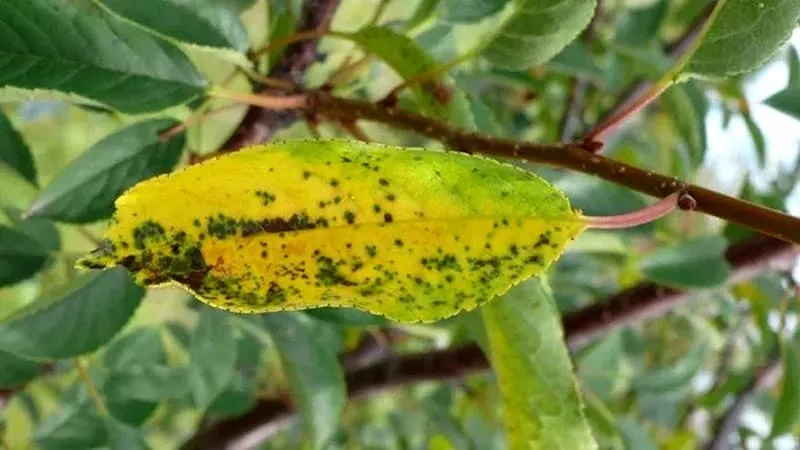
Nutrient Deficiency
Cherry trees require regular feeding throughout the growing season. Neglecting this or incorrect dosages can lead to nutrient deficiencies.
If the soil is unsuitable — for example, overly chalky or lime-rich (alkaline) — the tree struggles to absorb nutrients. This weakens the plant, stunts growth, and causes leaves to yellow and shoots to dry.
How to identify which minerals are lacking:
- Nitrogen deficiency: Small, pale green or yellowish leaves.
- Phosphorus deficiency: Short, dry shoots and narrow, discoloured leaves.
- Potassium deficiency: Bluish leaves with yellow-brown spots.
- Calcium deficiency: Dieback of young foliage.
- Boron deficiency: Chlorosis — yellowing veins and curled leaves.
- Zinc deficiency: Brittle, discoloured leaves.
Note. Over-fertilisation harms the tree. If leaves drop in July, it may indicate excessive nitrogen.
Diseases
No cherry variety is entirely disease-resistant, so regular inspections are essential. Early treatment saves both the harvest and the tree.
Coccomycosis
Coccomycosis is a fungal disease common in temperate European climates. It affects young and mature trees alike. Small red-brown spots appear on leaves, later merging into larger patches.
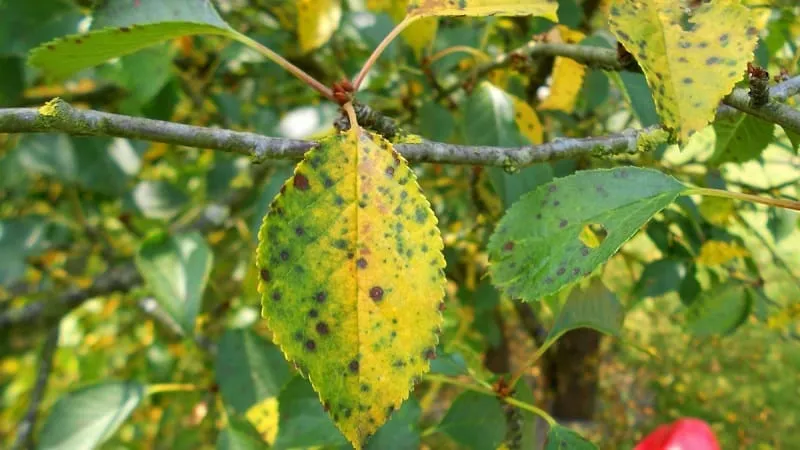
This reduces chlorophyll levels by half, impairing the tree’s ability to retain moisture. Leaves yellow and fall by mid-summer, weakening the tree’s immunity and disrupting biological processes.
Moniliosis (Fruit Rot)
Moniliosis, or fruit rot, is a fungal disease prevalent in cool, damp spring climates. The fungus attacks during flowering.
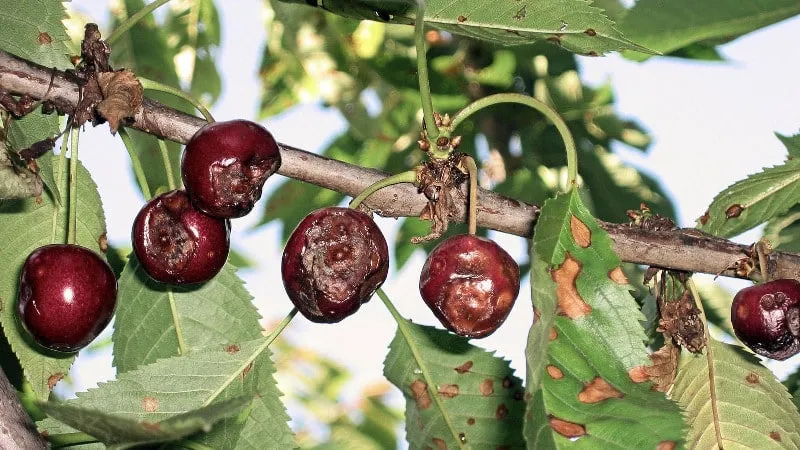
Key symptoms include:
- wilted, yellowing leaves;
- dying flowers;
- rotting fruit;
- scorched-looking shoot tips;
- grey bark growths.
Verticillium Wilt
Verticillium wilt is a dangerous fungal disease causing tree decline. It primarily targets young saplings. Leaves curl along veins, buds wilt, and fruit fails to ripen. Eventually, leaves yellow and drop, leaving the tree bare.
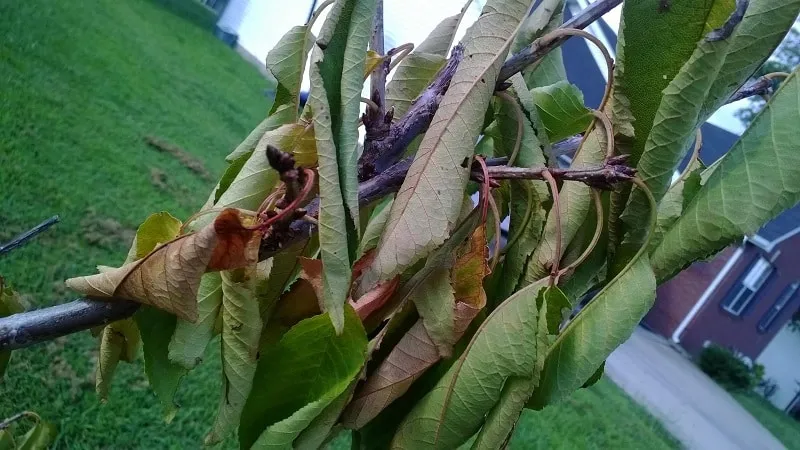
Scab
Cherry scab is a fungal disease that harms fruit yield. Infected leaves develop yellow spots that darken and crack. High humidity, overcrowding, and poor sunlight encourage its spread.
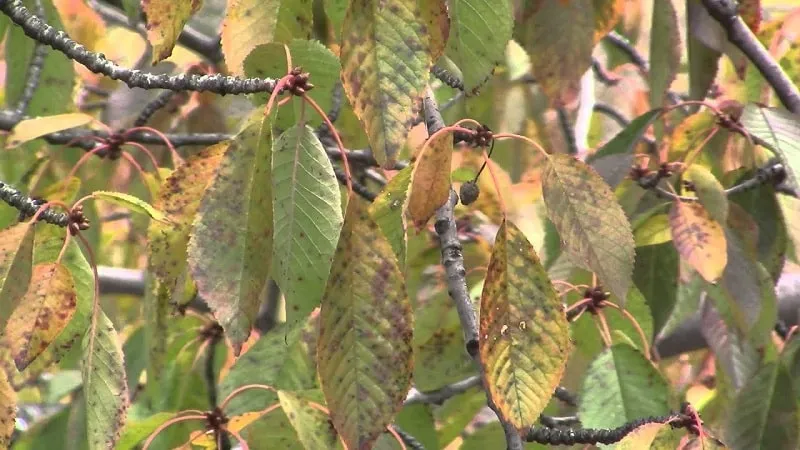
Chlorosis
Chlorosis is a non-infectious condition. Symptoms include yellowing summer leaf drop. It often affects trees in alkaline soils, waterlogged ground, or with mismatched rootstock-graft combinations.
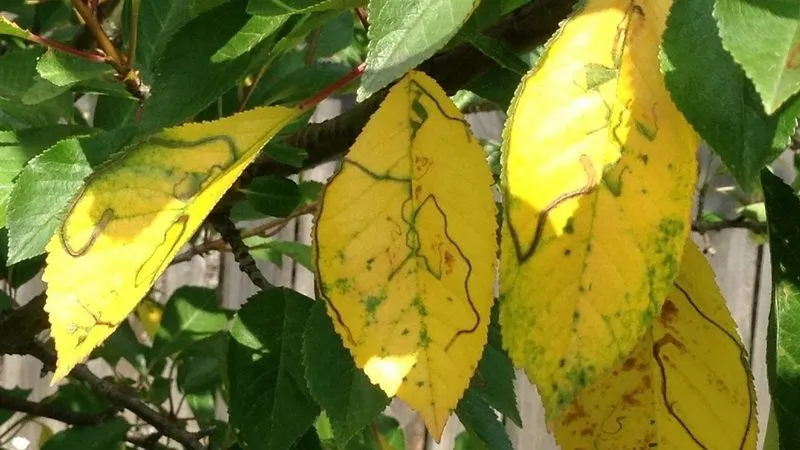
Chlorosis may follow winter frost damage, drought stress, or excessive rainfall.
Pests
Pests also cause yellowing and leaf drop. Early detection and control protect both fruit and tree. Common culprits:
- Cockchafer beetles: Larvae (1.5-4 cm long) feed on roots.
- Ants: Nest in roots, visible via soil mounds at the base.
- Cherry aphids: Tiny (≤2 mm) sap-sucking insects on shoot tips.
- Slug sawfly: 4-6 mm brown/black insects that drain sap.
- Bark beetles: Tunnel into bark, introducing fungal infections.
Growing Mistakes
Yellowing summer leaf drop often results from incorrect planting or care, potentially killing the tree.
Common errors:
- Planting in acidic soil (cherries prefer neutral pH).
- Spacing trees less than 2 m apart.
- Choosing shaded locations.
- Irregular watering or using cold water.
- Over- or under-fertilising.
- Neglecting pruning, leading to dense canopies.
- Using dirty gardening tools.
- Failing to mulch or aerate soil.
- Not clearing weeds and debris.
Treatment: Saving Your Tree
For drought stress, increase watering. Nutrient deficiencies require phosphorus, potassium, or wood ash supplements.
Fungal disease treatment:
- Post-harvest, spray with 1% Bordeaux mixture (100g copper sulphate + 150g lime per 10L water).
- Prune and burn infected branches.
- Treat cuts with lime wash containing 1-3% copper/iron sulphate.
Note. For coccomycosis, use "Score" fungicide (1 ampoule per 10L water).
Chemical treatments like "Horus", "Captan", or "Strobi" combat diseases and pests. Follow label instructions. Severely infected branches should be burned. Mustard solution (100g powder per 10L water) strengthens immunity when sprayed at dawn.
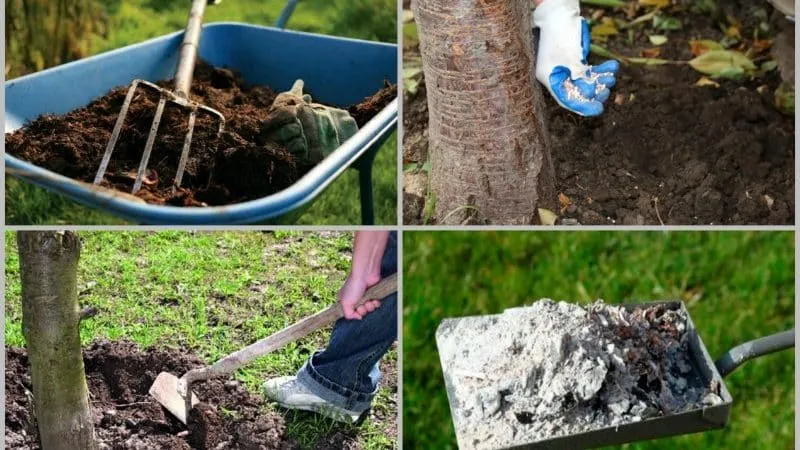
Pest control:
- Hand-remove insects or hose them off, then drench soil with boiling water.
- Flood ant nests with wormwood/mint tea or coat trunks with tar.
- Dig up and destroy cockchafer larvae; plant poisonous lupins nearby.
Chlorosis recovery:
- Use soft (rain/pond) water.
- Avoid fresh manure; opt for diluted bird guano (1:10-12).
- Foliar spray iron sulphate (50-70g/10L) thrice at 2-week intervals.
- Autumn treatment: 150g iron sulphate + 10kg compost at 60cm depth.
- Aerate roots with potassium permanganate (30-40g/10L; 10L per tree).
Pre-budburst, spray crowns with iron sulphate (300g/10L) to prevent chlorosis.
Addressing Leaf Drop
For severe leaf loss:
- Prune dead/diseased branches.
- Clear and burn fallen leaves/weeds.
- Apply ammonium phosphate (30g/m²) in autumn trenches.
- Dust bases with wood ash to boost immunity.
- Loosen soil, water with warm water, then feed with balanced fertilisers ("Kemira", etc.).
Preventive Measures
To avoid yellowing:
- Select region-appropriate varieties.
- Plant in sunny spots away from apples/pears.
- Inspect regularly for pests/diseases.
- Prune in dry weather using sterilised tools; seal wounds.
- Water at roots, avoiding foliage.
- Fertilise timely.
- Autumn tasks: Dig soil, remove weeds/debris.
- Whitewash trunks with copper sulphate-laced lime.
- Winter protection: Mulch and wrap trunks.
Expert Tips
For eco-friendly care:
- Spray with nettle/dandelion/chamomile tea (steep 1:1 in boiling water for 2 days).
- Apply fungicides/insecticides pre-fruiting for chemical-free harvests.
- Plant garlic, marigolds, or tobacco as pest deterrents.
Conclusion
Summer yellowing of cherry leaves demands immediate action. Common causes include improper watering, nutrient shortages, pests, or fungi. Timely intervention preserves both tree and harvest. Consistent prevention ensures long-term tree health.







